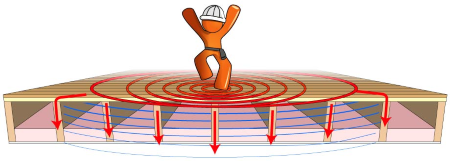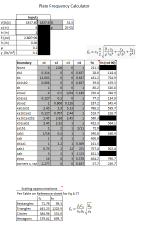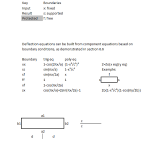Flat Plate Natural Frequency Calculator

Description
“a” and “b”, the dimensions of the plate
“c” and “d”, the half-dimensions of the plate (for polynomial equations)
“E”, plate material Young’s modulus
“h”, the plate thickness/height
“?”, plate material Poisson’s Ratio
“?” or “
“D”, plate stiffness factor (defined on References sheet)
“Z”, plate deflection at resonance
Calculation Reference
Flat Plates
Plate Bending
Strength of Materials
The natural frequency of a flat plate is an important parameter when designing structures or components subjected to dynamic loading or vibrations. To calculate the natural frequency of a flat plate, you can use the following steps based on classical plate theory and the Rayleigh-Ritz method:
-
Define plate geometry and properties: Determine the dimensions (length 'a' and width 'b') and thickness 'h' of the flat plate. Identify the material properties, such as Young's modulus 'E' and Poisson's ratio 'v', and calculate the mass density 'ρ'.
-
Boundary conditions: Specify the boundary conditions of the plate, which can be simply supported, clamped, or free on its edges.
-
Formulate the governing equation: Use the classical plate theory to derive the governing equation for the flat plate, which involves the deflection of the plate (w) and its bending stiffness (D). The bending stiffness (D) can be calculated using the formula:
D = (E * h^3) / (12 * (1 - v^2))
- Assume a deflection shape: Assume a sinusoidal deflection shape for the flat plate, which can be expressed as a product of sine functions in both the x and y directions:
w(x, y) = A * sin(m * π * x / a) * sin(n * π * y / b)
where 'A' is the amplitude, and 'm' and 'n' are the mode numbers in the x and y directions, respectively.
-
Apply the Rayleigh-Ritz method: Apply the Rayleigh-Ritz method by substituting the assumed deflection shape into the governing equation and calculating the strain energy (U) and kinetic energy (T) of the plate.
-
Calculate the natural frequency: The natural frequency (ω) can be obtained by minimizing the Rayleigh quotient, which is the ratio of the strain energy (U) to the kinetic energy (T):
ω² = U / T
Calculate the natural frequency (ω) by taking the square root of the obtained value for ω².
- Convert to frequency: Convert the natural frequency (ω) to frequency (f) using the following formula:
f = ω / (2 * π)
These steps provide an approximate method for calculating the natural frequency of a flat plate based on classical plate theory and the Rayleigh-Ritz method. The accuracy of this method depends on the complexity of the plate geometry, boundary conditions, and material properties. For more accurate results, especially for complex or irregular plates, consider using numerical methods, such as the Finite Element Method (FEM), which can provide detailed solutions for the natural frequencies and mode shapes of the plate.
Calculation Preview
Full download access to any calculation is available to users with a paid or awarded subscription (XLC Pro).
Subscriptions are free to contributors to the site, alternatively they can be purchased.
Click here for information on subscriptions.





